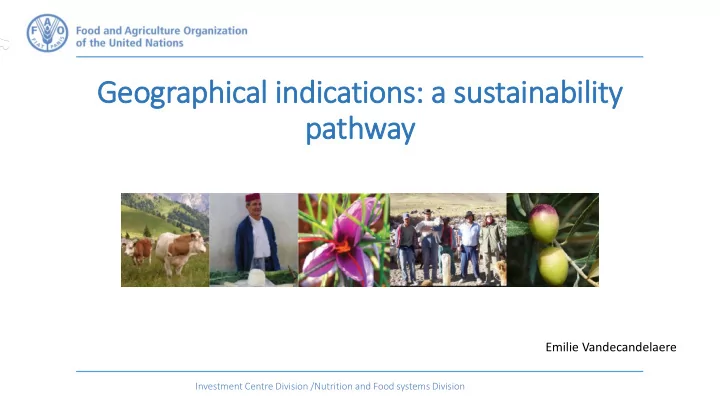

Geographical indications: a sustainability pathway Emilie Vandecandelaere Investment Centre Division /Nutrition and Food systems Division
In a context of world climate change, • 793 million people suffer from chronic hunger population growth, globalization and • 161 million children under the • 3.4 million people die each age of five are stunted specialization of agriculture, agriculture and year due to overweight and obesity • The cost of malnutrition is food systems are facing important of about 3.5 trillion USD per year challenges in terms of their sustainability 1.2 billion people work in agriculture - about 31% of the Agriculture uses global workforce 70% of global water withdrawals Territorial approaches are key to implement 2030 agenda The food system causes more than 20% of global Agriculture occupies greenhouse gas emissions 29% of commercial fish nearly 40% of total land populations are fished at area and is a major driver at an unsustainable level of deforestation
Sustainability is is embedded in in GI, I, around th three specificities: Biodiversity, Terr rroir ir – preserv rvatio ion of f lo local l reso sources landscape… A place based approach , similarities with agroecology principles Food heritage, Local resources, link with origin that is formalized as rules into a tailored made food diversity specifications - traditional knowledge, biodiversity To be preserved for the economic value in the future Nutrition security Endogenous develo lopment: : Women empowerment governance, ownership ip, stewardship ip Creation and redistribution of values to local Consumers Small holders and women empowerment protection Outmigration Mark rket tool l combin ined to publi lic goods (cu (culture, territ itory, etc. Resilience Consumer guarantees Rural Public – private coordination and policies, local, national, international development Inclusiveness …
1. IDENTIFICATION: o What are the sustainability challenges for the territory ? o Priorities to address in the three dimensions? o How GI processes can address them? (within specifications or other approaches) 2. QUALIFICATION : o Elaboration of the specifications need to take into account the human/cultural and natural resources o Establishment of good Governance 3. REMUNERATION; o economic sustainability through right partnerships and relevant markets o Communication about the sustainability in relation with GI nature 4. REPRODUCTION OF LOCAL RESOURCES o Is a pathway not a state – keep adjusting system to the needs, improving the system in a iterative way 5. ROLES OF PUBLIC ACTORS : supportive policies or regulation for compulsory measures?
What is needed? Stakeholders are not enough aware of the sustainable nature of GI Better to communicate and raise awareness, especially producers and consumers Sustainability is a complex matter … challenges are different according to the production system need for apropriate framework and tools for GI producers to make decision in a participative manner How to preserve the « GI concept » ? Assessment that take into consideration GI specificities Approaches that preserve producers leadership supported by relevant expertise Tools that can be managed by GI associations and producers themselves
How to do? Technical assistance Sensitization and capacity building in different ongoing projects (e.g. Action plan for the Continental GI strategy for Africa, technical cooperation in Asia, Central Asia etc.) Guidance tools • Guidelines for evaluation of GI impacts – prospective and retrospective, with University of Florence (forthcoming) • Preparation of publication on Best practices for GI sustainability with Strenght2Food project and University of Parma FAO and oriGIn collaborations
FAO and oriGIn Collaborations • 2016-2017: benchmark study • May 2017 expert meeting and task force for the preparation of the Sustainability Strategy for GIs (SSGI) • October 2017 : SSGI endorsed at oriGIn General assembly in Treviso: 1. support their members and other stakeholders in the prioritization of issues in line with local contexts 2. provide knowledge and tools that can help self-assessment, target setting and continuous improvement 3. more systematically communicate sustainability to stakeholders, as an additional point of differentiation apart from quality and reputation and as an avenue to build alliances to support territory sustainability objectives. IMPROVE the GI PRIORITIZE Sustainability ASSESS the needs and performance by topics for Geographical opportunities for action, Indications measuring COMMUNICATE
FAO and oriGIn Collaborations : • 2018 : Marcala Coffee DOP pilot and preparation and testing of tools • 2019 : Toolkit: support GI producers and their associations in the You will know identification and priorization of their sustainability challenges more in session F! IMPROVE the GI PRIORITIZE Sustainability ASSESS the needs and performance by topics for Geographical opportunities for action, Indications measuring COMMUNICATE • NEXT: • Develop GI sustainability framework for assesment and improvement in different sectors • June 2020: first biannual conference FAO-oriGIn
Thank you for your attention!
Recommend
More recommend